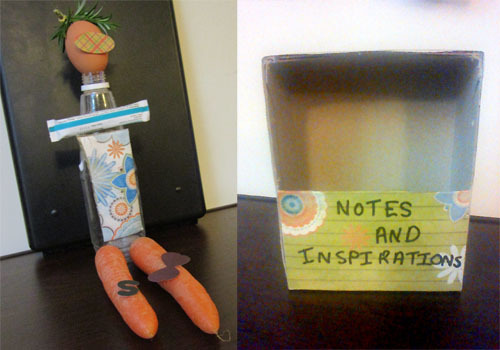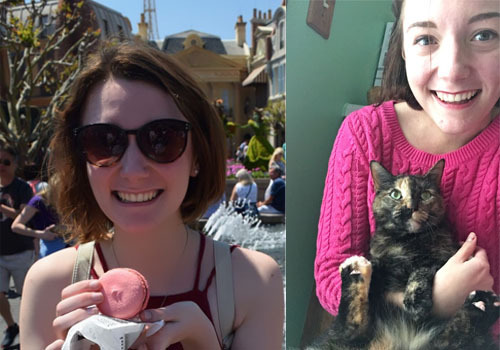Chris Baty's Blog, page 122
June 30, 2017
Camp Pep: Set Your Sights High

Camp NaNoWriMo is nothing without you, our incredible participants. Today, Claire Marino, a fellow Camper and member of the Young Writers Program, offers you some pep:
I was thirteen when I stumbled upon NaNoWriMo. I was looking for an outlet that would help me tap into my inner creativity, and I found one. But, a month? A full thirty-day month to commit to her writing project is a pretty big commitment for a thirteen-year-old kid in the middle of one of the most demanding months of the school year.
As I considered participating, I felt unqualified, unsure, and afraid. Everything around me was already taking a turn for the crazy. Why would I willingly throw myself into the center of another time-consuming adventure?
Roadblocks of self-doubt confronted me. Truth is, I’m still just about as “qualified” to write a novel as I am to operate heavy machinery. Which is to say, not at all. These obstacles almost stopped me from turning my writing from a hobby to a passion. But who creates the qualifications for what exactly makes a writer? Who decides whether or not I am capable? Well, I decided, I do.
November soon arrived, and through a whirlwind of uncertainty, I decided to throw my cares away and leap into my story. After all, what’s the worst that could happen? I could either win and make significant progress on a story I really cared about, or not win and be proud to have tried something new.
I spent that month with my hands glued to my keyboard, and my mom spent the month telling me to stop writing and go to sleep already. I spent every school day itching to get home and write, and every spare moment fantasizing about the story that couldn’t stop bleeding from my fingertips.
By the end of the month I was thoroughly exhausted. I had reached my goal with time to spare and kept going. I felt like I was flying, like I was on fire, like nothing could stop me. The second November ended, I found myself wishing for another session to start. Little did I know April Camp was just a few months away.
If I hadn’t participated in that first NaNoWriMo, I would still consider my passion for writing just another hobby. If I hadn’t taken the leap that November, I wouldn’t have had the courage or mind to keep creating throughout the increasing pace of life.
Looking back, I can honestly say that if I didn’t have a NaNoWriMo session every few months, I would not still be writing. Sometimes life just takes over, and you need an opportunity like NaNoWriMo to push you back into the habit of writing.
If there is one idea that always gives me the motivation to write, it’s this: You are the only person that has and ever will exist with a voice quite like yours, which is such a beautiful thing. No one can tell a story quite the way you can. No one can create quite the way you can. You are the only one who can tell your story.
All it takes is one leap of faith to turn your writing hobby into something bigger, to prove to yourself that you are capable of doing much more than you might think. Take a leap this month. Work towards a writing goal that’s right for you. What’s the worst that can happen?

Claire Marino is a high school sophomore who lives in the northeastern United States and spends her time doing all things creative. She enjoys singing very loudly, dancing, acting, writing, reading, doodling, and coloring in adult coloring books. She especially enjoys poetry and stories that have at least one sassy side character. She has been participating in NaNoWriMo since November 2015, and has met her goal every time.
June 29, 2017
"When you begin to plan your project, start small! Then let it snowball. I admit, my longest outline..."
1. Start with your elevator pitch (a one-sentence run down of the who, what, where, when, and especially why of your story).
2. Expand that one sentence into three: beginning, middle, end.
3. Expand those three sentences into three paragraphs for beginning, middle, and end, adding details to each section.
4. Break those three paragraphs into multiple paragraphs for each section, adding even more details—and turning those details into potential scenes.
5. Group the scenes (and use flash cards if you want to, for easy movement) into paragraphs of action, which then magically become chapters!
6. Voila, you should now have a skeleton outline featuring three sections of multiple paragraphs outlining your chapters by beginning, middle and end.”
-
Sona Charaipotra first worked as a celebrity reporter at People and (the dearly departed) TeenPeople magazines, and has been a contributor to publications from the New York Times to TeenVogue. She’s the co-founder of CAKE Literary, a boutique book packaging company with a decidedly diverse bent, and the co-author of the YA dance dramas Tiny Pretty Things and Shiny Broken Pieces. She’s also proud to serve as the head of content for the non-profit We Need Diverse Books.
Your Camp Care Package is brought to you in partnership with We Need Diverse Books. Sign up to receive more Camp Care Packages at campnanowrimo.org.
June 28, 2017
4 Steps to Start Editing a Mess

We’re getting ready for Camp NaNoWriMo this July! This month, we’re talking to Wrimos who are using the Camp format to work on non-novel projects. Today, participant Sofie Riis Endahl shares some of her tips for diving into editing work when your manuscript seems like such a mess that you’re not even sure where to start:
You did it! You finally wrote the last word of the last scene of the last chapter! You wrote a novel!
But then you took some weeks or months or years away from the keyboard, and now when you read your manuscript again, an awful thought hits you: The supercalifragilisticexpialidocious novel you wrote is maybe not that supercalifragilisticexpialidocious after all.
This is ok. It’s a draft––maybe even a pretty rough draft, maybe even a just a mess of words and ideas (and plot lines that you lost track of about halfway through).
But where do you start editing? And how do you avoid just making your novel an even bigger mess?
1. Read your novel.First of all you need to print out your manuscript (or convert it to ePub and read it from your tablet), preferably in different font than the one you wrote it in. Then read it as if you were a reader or editor. Jot down your thoughts in the margin or in your notebook. Mark the good things with green and the bad things with red. Mark what you don’t understand, what you find boring––mark that joke that should be funny but just isn’t.
2. Know your novel.To edit your novel without making it a bigger mess than it already is, you need to know where your novel is going and what it’s trying to convey. Maybe you already answered these questions before you started writing––but the answers might have changed, so answer them again:
What is the theme of your story? (What is the message? What is the truth that your protagonist realizes at last that makes him able to kill those dragons or stand up to those bullies?)How is your protagonist different at the end than who she was at the beginning?
What is your story’s 1st, 2nd, and 3rd plot point? What is the climax?
3. Make a diagnosis.
Now you know your novel––but to turn your mess into a supercalifragilisticexpialidocious novel, you need to know what exactly makes your novel a mess: you need to diagnose your novel just as if you were a doctor. Look at your notes and markings from when you were the reader: Were there some plot holes, or parts that didn’t make sense? Or maybe you barely have any descriptions? Or maybe your characters all sound the same?
Write down all the problems and how you will fix them. Maybe you will let the protagonist overhear a fight between the antagonist and the protagonist’s ally to fix that plot hole. Maybe you’ll add at least two descriptions to each scene. Or maybe you’ll start writing down things other people say to work them into your characters’ dialogue to make them have distinctive voices.
4. Make a plan.Now you know what you need to focus on. But if this list is too long, you might have to edit your novel twice. Make a plan of how you will edit it. Maybe you will edit one section at a time. Or maybe you’ll rewrite the ending first and then edit the beginning.
It is often a good idea to have two kinds of edits: the macro edit, where you edit plot and character development, and the line edit: where you correct typos, add descriptions, and so on. Once you have a plan, all you have to do is follow it!
Good luck!

Sofie Riis Endahl is a 16-year-old Danish girl. She uses her age to bring authenticity into the 9 (not yet published) YA novels, she has written. You can find her short stories in a host of Danish short story or poetry collections, including Piger 2017 (Girls 2017). She has also written stories in collaboration with Save the Children, including Børn på Flugt (Child Refuges). She is an active user of the writing website Movellas, where she has worked as blogger and community manager.
Top photo by Flickr user risi ikeda.
June 26, 2017
"There are two kinds of writers (and people, I’d say) in this world: plotters and pantsers. And for..."
When it comes to tackling a big, fast drafting project for something like Camp, though, even the most die-hard pantser could learn a trick or two from us outlining Jedi. Luckily, as a screenwriter-turned-novelist (and back again!), I’m definitely a plot devotee. I’ve even managed to convert a pantser or ten in my time. This week I’ll be giving you some smart–and painless–tips to get you grounded on plot before you kick off your Camp NaNoWriMo adventure.
The first is simply this: Don’t be afraid to try something new. (Camp is supposed to be a time of exploration, after all!) If you’re a pantser who’s never made an outline before, I’ll talk you through it this week. And if you’re a fellow outline aficionado, just remember: nothing is set in stone yet. If a rogue idea sweeps you up during the process, don’t be afraid to run with it.”
-
Sona Charaipotra is not a doctor—much to her parents’ chagrin. They were really hoping she’d grow up to take over their pediatrics practice one day. Instead, she became a writer, working first as a celebrity reporter at People and (the dearly departed) TeenPeople magazines, and contributing to publications from the New York Times to TeenVogue. She’s the co-founder of CAKE Literary, a boutique book packaging company with a decidedly diverse bent, and the co-author of the YA dance dramas Tiny Pretty Things and Shiny Broken Pieces. She’s also proud to serve as the head of content for the non-profit We Need Diverse Books.
Your Camp Care Package is brought to you in partnership with We Need Diverse Books. Sign up to receive more Camp Care Packages at campnanowrimo.org.
June 23, 2017
Writing With Mobility Issues: How to Draft a Novel

We’re getting ready for Camp NaNoWriMo this July! This month, we’re talking to Wrimos who have tailored the Camp format to suit their writing habits. Today, participant Karen Haakma shares how to write a draft of your novel when some of the more commonly prescribed methods don’t work for you:
Meet Mackley. He has spiky hair, his forehead is wider than his chin, and his right limbs are shorter than his left. He has no fashion sense. A very indecisive dreamer, he hides it beneath a carapace of dependability and loyalty.
Mackley would never have existed if I had followed one of the more “traditional” formulas for planning a novel: “Go to the nearest mall / architecturally interesting building / sports game. Take multiple notebooks. Ask yourself screes of questions about what and who you see / hear / taste / smell / touch. Answer each one thoroughly in longhand. When you get home, transfer everything to index card. Lay them on the floor. Stand up. Examine the layout. Get down again and move the cards around. Stand up. Lather, rinse, repeat, until you’re satisfied with the result.”
This method presumes I can move around freely and read my handwriting on a 10x5 cm card from a standing distance. I can’t do either. Heck, I can hardly read my writing when it’s sitting on my wheelchair tray less than half a meter from my nose. It also presumes I can leave my home independently, and that wheelchair access is the norm. I can’t, and it isn’t.
So, should I give up because I have mobility issues and staring at pages of text leaves me lost and confused? Should you?
No. Not yet. At least try these tips first:
1. Identify your abilities.Can you:
Draw, paint, or sculpt?Cut, glue, staple, or tape?
Take photos?
Work a remote or a mouse?
Taking stock of what you are able to do can help you figure out the best way to gather and store ideas, inspiration, and information for your writing.
2. Identify your workspace.Is it:
A small area like a tray, over-bed table, or your lap?The circle of your arm’s reach?
A table or bench your wheelchair won’t fit under?
Can you use multiple areas to give you more room?
Try to make sure that your physical workspace allows you to use those abilities you just identified.
3. Identify your resources.Do you have:
Regular deliveries of medical / incontinence products?Packaging from ongoing prescriptions?
Materials you use for the skills identified in Step 1?
Food & food packaging?
Having all of your materials in a list and close at hand can help you feel prepared to begin.
4. Choose appropriate storage.Once you’ve answered the first three questions, you can start to decide how you are going to store the information and inspirations you gather. Why storage first? Because it’s extremely frustrating to jot an exciting idea down on a scrap of paper, only to find it a week later and think “What does ‘Mackley’s circular dachshund’ even mean?” (I still don’t know!)
Some storage ideas are:
A mini filing box made from a pill box.Memo cards folded over a ribbon strung between two portable objects or pinned to a wall. Wire racks (like those from the oven) can also be used.
A spiral-bound pad can be the basis for a visual Mind Map. Thread a piece of wool through the top and hang it somewhere. I am going to use Mackley’s photo to inspire one of these about him.
Voice recordings are handy when you’re low on energy.
Some ideas are “instant storage.” This means that the information gathering and the storage happen simultaneously–Sculptures, models, pictures, and photos are some examples.
Find your inspiration, then store it immediately–don’t wait!
5. Look to commonplace objects for inspiration.Be creative!
I’ve watched a TV show through a camera lens just to get a photo of a particular person / place / object.Movies, video clips, and TV shows, especially when muted, can teach a lot about movement and interaction. Documentaries and news bulletins give realistic snapshots of nature.
I needed a river for a 3D map, so I cut the excess tubing from an IDC bag, wrapped it in blue ribbon, and taped it in place.
Plastic packaging can be moulded into hills and mountains.
Small boxes can be made into buildings.
Textures are my favorite for internal character development. Close your eyes. Take into account not only what your skin feels, but what you know about the object you’re touching. Does it melt or harden when hot? When squeezed, does it keep its shape or explode?
I’ve gotten free note pads by ordering free paint sample cards online.
Pretty much anything can be used to conceptualize a physical description of a character.
For me, writing is the most accessible activity of all. It doesn’t cost a lot of money. It doesn’t need travel. It doesn’t need a lot of bending and stretching. All it needs is you, your imagination, and some out-of-the-box thinking.

Karen Haakma lives in Hamilton, New Zealand. Though she has wheels for legs, she hates the word ‘disabled’, preferring to be called a cripple. (To see why, read the explanation on her fanfiction profile). She has participated in NaNoWriMo for 4 years and won each time, though she has only finished 2 of those stories. She has written 23 fanfiction stories, and has ideas for 3 original novels. She enjoys amalgamating her love of craft with her love of writing. Visit her on Twitter @rhinosgirl40.
June 21, 2017
6 Steps for Editing Your Novel

We’re getting ready for Camp NaNoWriMo this July! This month, we’re talking to Wrimos who are using the Camp format to work on non-novel projects. Today, participant Lana Alam shares some of her tips for diving into editing work this summer:
If you have ever won NaNo, you probably have a pile of at least 50,000 words sitting in a folder on a computer collecting ‘dust’. Many of us finish a writing project with a huge sense of accomplishment–and then promptly forget about our work in progress.
The business of editing a rough draft is often a daunting one. This is in part because we go back and read through our novels right away. Our response is often a resounding: “Oh dear” (or something a little more colorful). When you reach this stage, here are six steps that can help you keep editing:
1. Don’t edit a project right after you’ve finished it.Ignore the temptation to read through your novel right away. Give it a month or two, but no longer than six, to get some distance from your work. Then, take a deep breath, grab your favorite beverage, and get comfy for a read-through. Yes, there will be gaping plot holes, problems galore, and probably a slight sinking feeling in your middle. Don’t let the problems get you down. Rather, focus on what is there–the parts of the story that do work.
2. Create an outline.Take the time now to create an outline if you didn’t make one before you started writing. You can jot down points as you read if that makes it easier. Play around and see if you can fix any of the plot holes. Look at the common themes in your book. Do they move the story forward?
3. Break up the work into smaller chunks.Break your story up into manageable sections or scenes and transfer these onto flash cards. Only jot down the important bits–you don’t want to write out your entire novel. Spread the cards out across a table, floor, or bulletin board. This will give you a better sense of your book. Plot holes and problems should become more obvious.
4. Pay attention to details.Often when we write fast, as is the case with NaNoWriMo, we tend to focus mostly on the important central thread of the story. Pay attention to the parallel narratives. Do your supporting characters get enough page time? Take the time to flesh out their stories. Create the flash cards and add them into your novel.
5. Cut out the things that aren’t working.Now is the time to cut the sections that don’t work. This is not always easy to do. Do you have secondary characters who add nothing to the book? Get rid of them. We want to ensure that the words that remain drive the novel forward. If there is a scene, character, or some dialogue that you absolutely love but which doesn’t belong in the novel any more, cut it and save it in a new document. Who knows, this little blurb may form the backbone of a completely new novel. Save it for the next round of NaNoWriMo.
6. Let the story grow into something new.Lastly, you have to be ok with letting the story evolve as you edit. The story in our head definitely changes once we have it down on paper, and this is ok. Let it happen. Writing a novel is a process–and not a quick one at that. Take the time to figure out what works and doesn’t work for you.
Novel writing is definitely not a one-size-fits all process. As long as you continue moving forward you are on the right track. Try to be patient. There are likely many, many edits and/or rewrites in your future regardless of the steps you take. Seeing your name on the cover of your printed novel at the end will make the whole journey one hundred percent worth it!

Lana was born in South Africa and moved to Calgary (Alberta, Canada) to complete a BA in English. She now lives in Ontario with her husband, two amazing children and a fish. When Lana isn’t doing arts and crafts with her kids, playing PS4 with her husband, baking, or reading she can be found doing freelance copywriting and editing for her company L.A. Editing. She is a certified book dragon, loves all things fantasy, and is currently editing her first novel.
Top photo by Flickr user Sebastien Wiertz.
June 19, 2017
Perfection is the Enemy: The Art of Persistence

Our Come Write In program provides libraries, bookstores, and other neighborhood hubs the resources to build and support a local writing community. Today, librarian Jennifer Joe at the Owensboro Regional Campus of Western Kentucky University shares how NaNoWriMo has taught her to embrace persistence and throw certain kinds of “perfection” out the window:
I am a campus librarian at a small, regional campus library in Kentucky. In fact, I am the campus librarian, which means that if activities are going to happen at my library, I am the one who is going to organize them. It took me three years on the job, but with some support from the larger university community, my library finally became a Come Write In location. As a passionate supporter of reading and writing, and a 10+ year participant of NaNoWriMo, it was my pleasure to finally combine my hobby with my profession.
However, this proved to be more difficult than I thought. We initially generated very little interest past “So what exactly is National Novel Writing Month?” We have a large white board in my library, on which I taped the NaNoWriMo poster that came in the library’s Come Write In kit. Next to it was a running tally for word counts of anyone who wanted to participate. In the middle of the month, there were three names on the board, one of which was my own. It was disheartening, but I persisted.
I told people that they could do it. I explained to them that motivation is the deciding factor, and perfection is the enemy.
I didn’t just mean the perfection of trying to get the words down in the right order the first time. My students are all adults (one of my participants is twenty-one, the other, old enough to be her mother), and I think they are old enough to realize that it is rare that anyone writes anything perfectly the first time.
Sometimes the real enemy can be thinking of “perfection” as obtaining your goal. Several people have balked at the idea of NaNoWriMo because they do not think they can succeed, and for them, if they do not succeed, they have gained nothing.
“Working to make your dreams a reality, even if they do not come to fruition this time, can give you the confidence to try again.”This goes against everything I have ever learned from NaNoWriMo. The goal has never been perfection. While getting to 50,000 words and getting that shiny purple bar would have been fabulous (both for me and for my two new participants), it is only secondary to the real goal: go for something you have never tried before, or that you have tried before and failed, and work harder than you ever thought possible. Working to make your dreams a reality, even if they do not come to fruition this time, can give you the confidence to try again. And again. And again. It’s about perseverance.
Near the end of the month, we had a late-comer join us. His tally, at least on my whiteboard, never reached past 5,000, but he–and the rest of us–can say we tried. And his is most definitely a story of rejecting perfection–he knew what a long shot it was that he could win, starting when he did. But he wrote anyway.
He has inspired me, too. If someone can join in at the last minute and have fun challenging themselves despite the obstacle, I can–and I will–keep promoting NaNoWriMo at my campus, even though my students are too busy, too concerned with school, too stressed with their everyday lives. Because NaNoWriMo has taught me perseverance, and I think it can help them, too.

Jennifer Joe is the Campus Librarian at Western Kentucky University’s Owensboro Regional Campus. She has been participating in NaNoWriMo for 12 years (and won 11 of them), but last year was the first year she guided other participants through the process! She’s excited about her library being a Come Write In location and hopes that it will help her students learn to pursue their passions no matter the obstacles.
Top photo by Flickr user Tien Phuc.
June 16, 2017
Meet Our New NaNo Intern, Emily Ehret!

We feel super lucky here at NaNo HQ to be able to work with some excellent interns! Today, meet intern Emily Ehret, the newest addition to our team. You’ll be getting to know her better as a co-host of Virtual Write-Ins throughout July’s Camp NaNoWriMo session, but today she’s sharing a few of the points on her personal compass that help guide her through new situations:
Hello writers! It’s my very first day in the office. I’m fresh off the plane from Chicago just yesterday, and the Bay Area is brilliant and entirely new to me.
As I learn more about the area, I’m thankful for my almost-uncanny orientation to the cardinal directions. No matter what, I can find north, and that got me from the airport terminal to my temporary summer residence and finally all the way here to the office. With this internship, I’m embracing change head-on, but there are always constants that help me find my way. Here are a few constants about me:
I’m very excited to learn at much as I can from my time here. With this new location and new internship will hopefully come many new stories and writing inspirations. While here, I will be participating in Camp NaNo myself, and I hope to balance the changes and constants in my life and keep moving in an exciting direction.
Emily Ehret
NaNoWriMo Intern
June 14, 2017
My NaNo Road Trip: A 1,000 Mile Walking Journey

We’re off on the Great NaNoWriMo Road Trip! So far, participants like you have helped us raise over $51,000 of our $50,000 goal to fund a redesign of the NaNoWriMo website. We’ve asked NaNoWriMo participants around the globe to tell us about their journeys along their own creative highways. Today, participant Alan Dix shares the amazing story of how his writing journey intertwined with a 1,000 mile long physical walking journey
:
I stood, hands on the rail, looking out across the wide dusk-stilled waters of the Severn hundreds of feet below. Lorries rumbled behind me, and muffled bird cries reflected back from the oily surface stretching towards the lights of the “New” Severn Crossing many miles away.
It was the end of the second day of my walking tour of Wales. I had set my back to the falling sun to cross the bridges across the Wye and Severn, rivers that drain nearly all of Wales, rising in far mountains just a few miles from the West Wales coast where I would be walking in two months’ time. This was not part of the official Coast Path, nor following the border, but a two-mile foray across to England to stay in Aust services, and a meeting with my past.
I thought of a first journey: this crossing as a child, in the back of my family’s blue Ford Popular, all bulbous, a car of a former age. Mum and Dad were in the front, my sister and I in the back. The 1966 Severn Bridge, itself new then, cut short the long journey upstream to Gloucester, and as we crossed the smaller Wye bridge, I never expected the scale of the grand bridge to come–one of the few times in childhood where reality outstripped my imagination.

When I first thought of the NaNoWriMo Road Trip, my mind turned to my own writer’s journey, not so unusual: (over)imaginative child, bullied a little, father died when young, (poor) teenage poetry, long years as an academic, very occasionally dabbling a toe into the waters of creative writing (via exploring the academic paper as an art form), and then NaNoWriMo giving me the opportunity to explore long-form fiction for the first time.
However, so much of my life story is now wrapped in this other journey. In 2013, I walked one thousand miles around the periphery of Wales: part academic expedition, part personal exploration, with about two thousand words of blog a day–the walker’s voyeur view.
I could take the walk as a metaphor for my NaNoWriMo month: part faithful parallel, part creative confabulation. There were many deep connections between my internal and external journeys–including the apparently unachievable over-commitment, and the brief glimpses into people’s lives.
Perhaps the most significant parallel was the importance of making the decision to go on such a grand adventure. During periods of pain (and there were many whilst walking those thousand miles), when I felt like I had no mental strength, no way to tough it through, the decision I’d made kept me going. With NaNoWriMo, there was none of the physical pain, but I felt the same pull of that important decision–so powerful.

In some ways the journeys of physical path and narrative path are different: one is there before you start; and one unfolds in front of you, almost of its own will. But both bring moments of surprise, and moments of serenity amongst the turmoil.
In my NaNoWriMo novel: Our protagonist finds herself in a bombed-out church after the Clydebank Blitz. Dappled sunlight through shattered stained glass plays on dust-strewn pews, and amongst the rubble she uncovers the altar cross, which–although terrified by the profanity of the act–she spits upon and cleans. She leaves it upright, battered but resilient, as she flees for fear of falling walls and divine judgment.
It’s a literary device, a parallel of her own life, a moment of hope amidst the depravity of war and broken idylls of island childhood. (Writing now, so soon after the Manchester bombing, the words hold special poignancy.)
Both my Wales walk and NaNoWriMo have been immensely transformative; in both, the return to ‘normal life’ jarring and yet familiar. Both reconnected me to childhood aspiration, and revealed new pathways.
It’s time to start a new journey.

Alan Dix is part-time Professor in Computer Science at the University of Birmingham, and part-time freelance researcher, consultant, and academic writer. He organizes the biannual maker meeting, Tiree Tech Wave, on the Scottish isle where he lives. He authored a leading textbook on human–computer interaction, and is currently working on two academic books on physicality in design and on statistics, and also a book based on his 2013 walk around Wales. NaNoWriMo was his first foray into long-form fiction. Learn more about Alan’s 1,000 mile journey, read excerpts from his NaNo novel, visit his website, or check out his soon-to-be published book.
June 12, 2017
My NaNo Road Trip: Tackling the Terrifying Deadline, One Step at a Time

We’re off on the Great NaNoWriMo Road Trip! So far, participants like you have helped us raise over $47,000 of our $50,000 goal to fund a redesign of the NaNoWriMo website. We’ve asked NaNoWriMo participants around the globe to tell us about their journeys along their own creative highways. Today, participant Violet Pollux shares how they face the pressure of deadlines, both in writing and in life
:
The deadline: it could be classified as an authentic torture method. Yet, at the same time, it’s that supportive voice at the back of your head that urges you to keep on writing.
I’ll be completely honest: pressure sucks. I hate it, even when I give create great things because of it. I study two careers in two universities, so I’m no stranger to pressure. I’m a musician in an orchestra that has rehearsals from Monday to Friday, and, as if that wasn’t enough already, I write. If you asked me how I manage to do everything, I couldn’t give an exact answer, a realistic one, but there’s one thing I do: I try to see the road step by step.
I’m used to having deadlines one right after the other, and sometimes they’re so demanding that I start to think I won’t finish on time, that I won’t make it. Pressure is something that can motivate you to keep on the track, but sometimes, the anxiety it generates could actually take you to the opposite direction.
My secret for not letting the pressure of the deadline kill me and my dreams and my mental health? I ignore it. I forget about it. I act as if it didn’t exist at all.I write because I love writing. I study because I love studying. I play an instrument because I love playing it, and the point is that that love should be the motivation to do those things, not a deadline. I mean, a deadline is awesome, it keeps you writing… but sometimes you focus on it so hard that you forget that the main reason why you’re doing this is because you love it.
NaNoWriMo 2016 was the hardest for me. I was at half of the month and didn’t even have 10K words written–I was about to lose my mind! I thought I couldn’t make it, but then I just sat down and wrote because that’s what I love doing, not because I was putting pressure on myself to get it done. In that weekend I wrote about 12K words. Why did I write that many words in so little time but didn’t in the days before? Because in that weekend I only focused on two things:
I was writing because I loved it, not because of anything else.I only cared about the next word, the next paragraph, the next scene, the next chapter.
Big things are done by little tiny steps, and those are the ones we should focus on. One thing that NaNoWriMo has taught me is this: If you focus on the next small step you have to do, and just forget about the rest of the world in the meantime–magic happens, and you finish on time.
I know how horrible it is to fight anxiety and stress and to constantly be under pressure–I live that daily. But, do you want to know what I discovered recently? Most of times I don’t succeed on things, it’s because of… well, me.
Sometimes I’m the one who stands in the way to my own success, and now that I’m aware of it, I’ll try not to do it. I hope you try not to do it, too, if that was your case.
And, if you asked me for advice on writing, or life itself, I’d tell you this:
Don’t let yourself be the stone on your own road. Don’t let yourself be the reason why you don’t succeed. Don’t let your thoughts bring you down, because you’re stronger than you think–and trust me, even if you can’t see the light at the end of the tunnel, you can do this, you will do it, because you’re capable of that and so much more.

Violet Pollux is a poet, writer, musician–or simply an artist. They live in Venezuela, where they were born and currently study Medicine and Educational Learning Disabilities. They dream of being an LGBTQ+ activist someday. Violet writes mostly in Spanish, their mother tongue, but also writes in English. You can find them on Twitter, Instagram and Facebook, and you can follow their blogs: they have one in English and one in Spanish.
Top photo by Flickr user j_arlecchino.
Chris Baty's Blog
- Chris Baty's profile
- 63 followers



